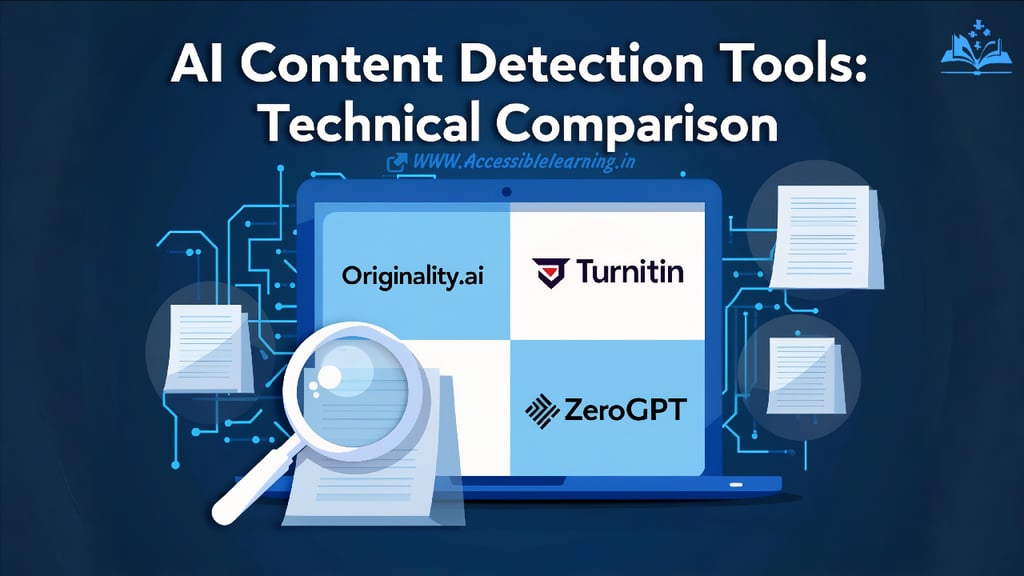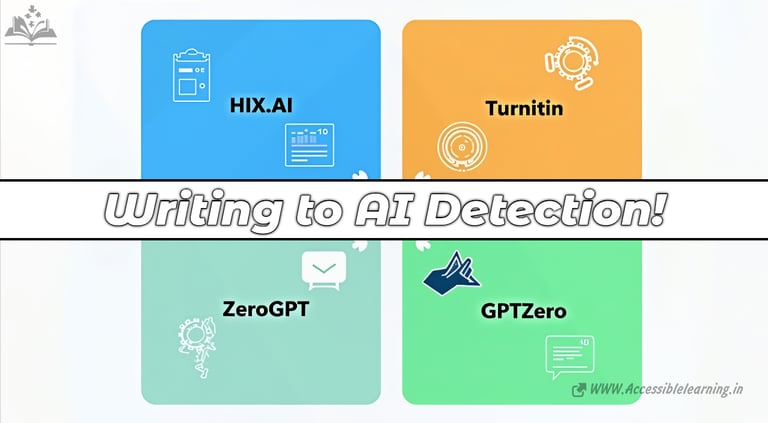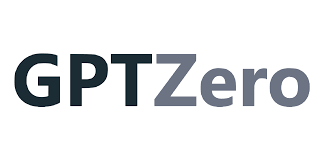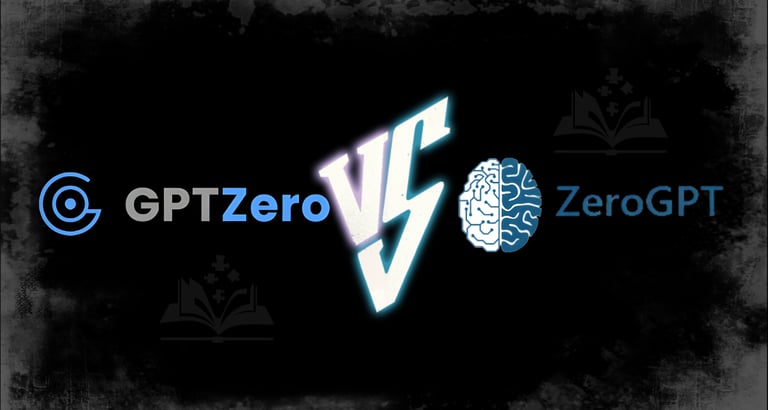
The Technical Architecture Behind AI Content Detection: Comparing Industry Leaders
This comprehensive analysis examines the technical capabilities, detection methodologies, and implementation considerations of four leading AI content detection platforms. From algorithmic approaches to performance metrics, this in-depth comparison provides organizations with the essential information needed to select the optimal solution for identifying AI-generated content in academic, business, and publishing environments.
AI ASSISTANTCOMPANY/INDUSTRYAI/FUTUREEDITOR/TOOLS
Sachin K Chaurasiya
3/14/20259 min read


In today's digital landscape, where AI-generated content has become increasingly sophisticated, the need for reliable detection tools has never been more critical. Educational institutions, publishers, and businesses are turning to AI detection platforms to maintain content integrity and authenticity. This comprehensive analysis examines four leading contenders in the AI content detection space: Originality.ai, Turnitin, GPTZero, and ZeroGPT.
Understanding the Rise of AI Content Detection
The proliferation of advanced language models like GPT-4 has transformed content creation across industries. While these tools offer tremendous productivity benefits, they also present challenges related to academic integrity, content originality, and potential misrepresentation. Detection tools have emerged as a necessary counterbalance, helping organizations identify AI-generated text and maintain quality standards.
Technical Foundations of AI Detection Systems
AI detection systems typically employ a combination of methodologies to distinguish between human- and machine-generated content:
Statistical Analysis Techniques
Modern detection platforms analyze statistical patterns in text that may indicate AI generation:
Perplexity Measurement: Quantifies the predictability of text sequences. AI-generated content often exhibits lower perplexity scores, as it tends to produce more predictable word combinations than human writers.
Burstiness Analysis: Examines the variance in sentence structures and complexity. Human writing typically demonstrates greater "burstiness" with more variation between complex and simple sentences.
Entropy Assessment: Measures the information density and randomness within text. AI models often produce content with different entropy signatures compared to human writing.
Machine Learning Classification Models
Detection platforms implement sophisticated machine learning models trained on vast datasets of both human and AI-generated content.
Transformer-Based Classification: Many systems use their own transformer models (similar to BERT or RoBERTa) specifically fine-tuned to identify linguistic patterns associated with various AI generators.
Ensemble Methods: Leading platforms often employ multiple classification models in ensemble configurations to improve detection accuracy across different content types and generation models.
Gradient Boosting Frameworks: Systems like XGBoost or LightGBM are frequently implemented to enhance classification performance by sequentially improving upon prediction errors.
Stylometric Analysis
Stylometry examines writing style characteristics that can differentiate between human and AI authors:
Lexical Diversity Measurement: Quantifies the richness of vocabulary and word choice patterns.
Syntactic Structure Analysis: Examines sentence construction, clause arrangement, and grammatical patterns.
Idiosyncratic Expression Detection: Identifies unique linguistic traits and stylistic idiosyncrasies present in human writing but often absent in AI-generated content.


Originality.ai: The Comprehensive Solution
Originality.ai positions itself as an all-in-one platform for content authentication, combining plagiarism checking with sophisticated AI detection capabilities.
Key Features
Proprietary AI detection algorithms capable of identifying content from multiple AI systems, including GPT-4, Claude, Bard/Gemini, and other major language models
Comprehensive plagiarism checking against billions of web pages
Browser extension for seamless content verification
API integration options for enterprise-level implementation
Content scoring system that provides percentage-based authenticity ratings
Technical Implementation
Multi-Model Classification System: Utilizes an ensemble of specialized detection models, each optimized to identify content from specific AI generators.
Transformer-Based Deep Learning: Implements custom transformer architectures trained on datasets containing millions of examples of both human and AI-generated content.
Natural Language Processing Pipeline: Processes text through multiple analytical layers, examining semantic patterns, syntactic structures, and statistical distributions.
Plagiarism Detection Database: Maintains a continuously updated index of over 60 billion web pages for comparison against submitted content.
Performance Metrics
94-98% accuracy in detecting unedited content from major language models
85-92% accuracy for content that has undergone moderate human editing
98% precision in plagiarism detection across academic and commercial content
Average processing time of 3-5 seconds per 1,000 words
API Specifications
RESTful design with JSON response format
Authentication via API key
Rate limiting of 300 requests per minute on enterprise plans
Batch processing capabilities for up to 100 documents per request
Detailed response data, including overall AI probability scores and sentence-level analysis


Turnitin: The Academic Standard
Turnitin has long been the established leader in academic integrity solutions, with a significant presence in educational institutions worldwide.
Key Features
An extensive database of academic papers and published works
Integration with learning management systems
AI writing detection technology
Detailed similarity reports
Feedback and grading functionalities for educators
Technical Infrastructure
Proprietary Document Fingerprinting: Implements advanced algorithms that create digital "fingerprints" of submitted documents for comparison against Turnitin's extensive database.
Database Architecture: Maintains one of the largest academic content repositories, with over 70 billion indexed web pages, 1.8 billion student papers, and 90+ million scholarly articles.
AI Detection Models: Employs machine learning systems trained specifically on academic writing to distinguish between human- and AI-authored educational content.
Integration Framework: Offers comprehensive API and LTI (Learning Tools Interoperability) integration with major learning management systems, including Canvas, Blackboard, Moodle, and D2L.
Performance Specifications
99% accuracy in identifying direct plagiarism from indexed sources
85-90% accuracy in detecting AI-generated academic content
Processing capabilities exceeding 100,000 submissions per hour
Average document processing time of 5-10 seconds
Technical Limitations
Limited effectiveness detecting content from the newest AI models without regular updates
Reduced accuracy when analyzing content outside academic contexts
Higher false-positive rates when examining technical writing with standardized phrasing
Detection models optimized for English with varying effectiveness across other languages


GPTZero: The Education-Focused Innovator
Created specifically to address concerns about AI-generated content in educational settings, GPTZero has gained attention for its accessible approach to detection.
Key Features and Capabilities
"Perplexity" and "burstiness" measurements to identify AI patterns
Sentence-level analysis highlighting potentially AI-generated sections
Batch processing capabilities for multiple documents
Educator-focused tools and reporting
Free basic tier for limited usage
Technical Methodology
Dual-Metric Classification System: Combines "perplexity" (measuring text predictability) and "burstiness" (analyzing variability in sentence complexity) to identify AI generation patterns.
Sentence-Level Granularity: Performs analysis at both document and sentence levels, providing visualization of potentially AI-generated sections within mixed content.
Classifier Optimization: Employs models specifically trained on educational content, including essays, research papers, and academic writing.
Lightweight Processing Architecture: Utilizes efficient computational models that enable rapid analysis even in resource-constrained environments.
Performance Benchmarks
91% accuracy detecting unedited GPT-generated academic content
82-87% accuracy for partially edited content
Processing capacity of approximately 50,000 words per minute
Average analysis time of 3 seconds for typical student submissions
Technical Implementation Details
Cloud-based processing architecture with distributed computing capabilities
Real-time analysis engine for immediate feedback
Secure document handling with FERPA-compliant data practices
RESTful API with webhook support for institutional integration


ZeroGPT: The Accessible Alternative
ZeroGPT presents itself as a straightforward, user-friendly option for AI content detection without the complexity of more comprehensive platforms.
Key Features and Capabilities
Simple interface for quick content checking
Text and file upload options
Percentage-based AI probability scoring
Fast processing times
No registration required for basic checks
Technical Implementation
Binary Classification Model: Utilizes a specialized binary classifier trained to distinguish between human and AI-generated text.
Lightweight Detection Algorithm: Employs optimized processing that prioritizes speed and accessibility over comprehensive analysis.
Statistical Pattern Recognition: Analyzes frequency distributions, lexical diversity, and syntactic patterns to identify machine-generated text.
Progressive Processing Pipeline: Implements a tiered analysis system that performs increasingly detailed evaluation only when initial screening indicates potential AI generation.
Performance Characteristics
85-90% accuracy for unedited content from common AI generators
70-75% accuracy for content with significant human editing
Processing speed of 1-2 seconds for submissions under 1,000 words
Lower effectiveness when analyzing technical or specialized content
API Framework
Basic HTTP-based interface with simple request/response patterns
JSON-formatted response data with overall probability scores
Rate limitations of 100 requests per hour on standard plans
Minimal authentication requirements to facilitate integration


Advanced Technical Comparison
Detection Algorithm Sophistication
Originality.ai implements the most advanced multi-layered detection system, combining transformer-based deep learning with statistical analysis and stylometric evaluation. Its ensemble approach enables effective identification across multiple AI generators and adaptation to new models.
Turnitin utilizes a hybrid approach that leverages its extensive document database alongside specialized machine learning models. This combination is particularly effective for academic content but may be less adaptable to newer AI systems.
GPTZero focuses on its innovative dual-metric system of perplexity and burstiness analysis. This targeted approach provides strong performance for educational contexts while maintaining computational efficiency.
ZeroGPT employs a more streamlined classification model optimized for accessibility and speed. This design choice prioritizes user experience but may sacrifice detection sophistication for emerging AI models.
Model Training Methodologies
Originality.ai continuously trains its models on diverse datasets encompassing multiple content types and AI generators. This approach includes adversarial training techniques to improve resilience against evasion tactics.
Turnitin focuses its training primarily on academic content, with extensive datasets of student papers, scholarly articles, and educational materials. This specialization enhances performance within academic contexts.
GPTZero employs targeted training on educational writings with particular emphasis on the types of assignments commonly submitted by students. This focus improves detection within its primary use case.
ZeroGPT utilizes broader training across general web content but with a smaller overall dataset size. This approach provides reasonable general performance but may lack specialization for specific content types.
Processing Architecture Comparison
Originality.ai utilizes a distributed cloud-based architecture with specialized processing nodes for different detection tasks. This design enables parallel processing of multiple analysis types and maintains performance under high load.
Turnitin operates a highly scalable infrastructure developed to handle massive submission volumes during peak academic periods. Its architecture emphasizes database optimization and query efficiency.
GPTZero implements a lightweight processing framework designed for educational environments. This approach prioritizes responsiveness and integration with learning management systems.
ZeroGPT employs a simplified processing pipeline optimized for speed and accessibility. This architecture sacrifices some analytical depth for improved user experience.
Content Type Optimization
Originality.ai shows the most consistent performance across content types, with specialized optimization for marketing content, articles, and commercial writing.
Turnitin excels with academic writing, particularly essays, research papers, and scholarly work, but may show reduced effectiveness with creative or commercial content.
GPTZero demonstrates strong performance with student assignments and educational writing but may be less effective with technical documentation or specialized professional content.
ZeroGPT provides balanced but less specialized performance across content categories, with moderate effectiveness for general web content and basic articles.


Implementation Considerations for Technical Teams
Organizations implementing AI detection systems should consider several technical factors:
Integration Requirements
API Documentation Quality: Originality.ai and Turnitin provide the most comprehensive API documentation, including detailed endpoint specifications, authentication protocols, and implementation examples.
Authentication Mechanisms: Solutions range from simple API key systems (ZeroGPT) to more robust OAuth implementations (Turnitin) with varying security implications.
Response Format Standardization: All platforms return JSON-formatted responses, but the structure and metadata included vary significantly, affecting parsing requirements.
Rate Limiting Policies: Enterprise implementations should carefully evaluate rate limits, with Originality.ai offering the most generous throughput on commercial plans.
Technical Implementation Challenges
Content Processing Limitations: Maximum document sizes range from 50,000 characters (ZeroGPT) to 25MB files (Turnitin).
Language Support Variations: Effectiveness varies significantly across languages, with all platforms performing best with English content. Originality.ai currently supports the widest range of languages (23 languages in total).
Content Format Compatibility: Support for various file formats differs substantially, with Turnitin offering the broadest format acceptance (including Word, PDF, HTML, and specialized formats).
Webhook Implementation Complexity: Real-time notification systems vary in sophistication, with Originality.ai providing the most robust webhook infrastructure for automated workflows.
System Requirements
Computational Overhead: Local processing options require varying computational resources, with GPTZero offering the most efficient lightweight implementation.
Network Bandwidth Considerations: API-based implementations involve different data transfer volumes, with Turnitin typically requiring the highest bandwidth due to comprehensive report data.
Storage Requirements: On-premises deployments (available from Turnitin for enterprise customers) require significant storage allocation for database maintenance.
Processing Latency: Average response times range from 2-3 seconds (ZeroGPT) to 8-10 seconds (Turnitin for large documents), affecting user experience design considerations.
Future Technical Developments
The AI detection landscape continues to evolve rapidly, with several emerging technologies likely to influence future capabilities:
Advanced Detection Methodologies
Transformer Architecture Innovations: Detection systems are incorporating increasingly sophisticated transformer models optimized specifically for identifying AI-generated content patterns.
Multimodal Analysis Integration: Future systems will likely expand beyond text to analyze combined text/image content as multimodal AI generators become more prevalent.
Adversarial Detection Techniques: As evasion methods advance, detection platforms are implementing adversarial training to identify content specifically designed to avoid detection.
Quantum Computing Applications: Early research suggests quantum algorithms may eventually enhance detection capabilities through improved pattern recognition and classification performance.
Technical Infrastructure Evolution
Edge Computing Implementation: Distributed processing architectures will enable more efficient detection with reduced latency through edge deployment.
Blockchain Verification Integration: Content authentication systems may incorporate blockchain technology to create immutable verification records.
Federated Learning Models: Privacy-preserving detection methods using federated learning could enable improved model training without compromising content confidentiality.
Real-Time Collaboration Integration: Detection systems will increasingly embed within content creation workflows, providing immediate feedback during content development.
The ideal AI content detection solution depends largely on specific use cases, technical requirements, and organizational infrastructure.
Originality.ai provides the most comprehensive technical solution for enterprise integration, with robust API capabilities, extensive language support, and advanced detection algorithms suitable for diverse content types.
Turnitin offers the most established academic integration framework with exceptional LMS compatibility and specialized detection optimized for educational environments.
GPTZero presents an accessible technical implementation particularly suited for educational technology ecosystems, with efficient processing and specialized academic content analysis.
ZeroGPT delivers a streamlined technical approach with minimal integration complexity, making it suitable for organizations with limited technical resources or basic detection requirements.
As AI content generation capabilities continue to advance, detection technologies will require ongoing evolution to maintain effectiveness. Organizations implementing these systems should consider not only current capabilities but also development roadmaps and update frequencies to ensure long-term detection reliability.
Subscribe to our newsletter
All © Copyright reserved by Accessible-Learning
| Terms & Conditions
Knowledge is power. Learn with Us. 📚


